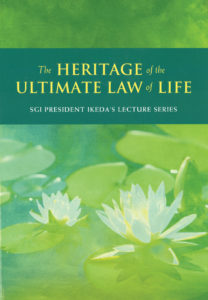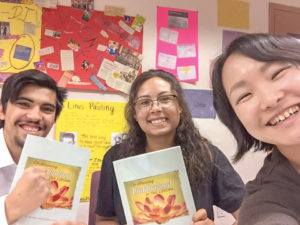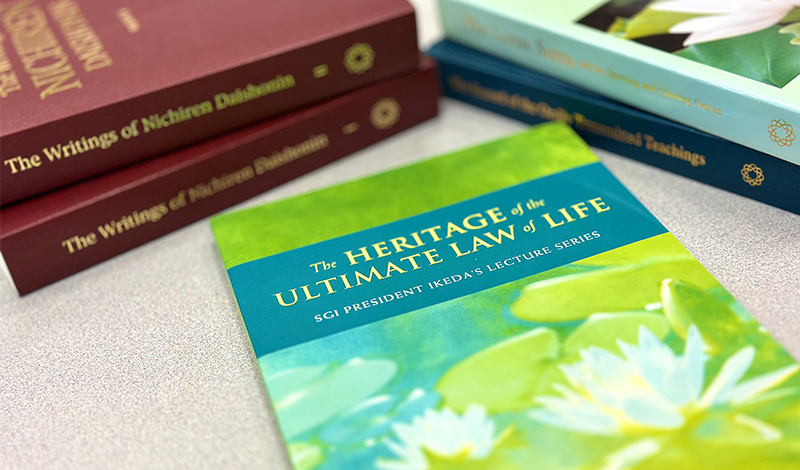The Ikeda Wisdom Academy is an SGI-USA youth division movement to engage youth leaders in advanced study. This month, academy members will study chapter 1 of The Heritage of the Ultimate Law of Life: SGI President Ikeda’s Lecture Series.
While the Ikeda Wisdom Academy is a youth leaders study program, all SGI-USA members are invited to utilize this section of Living Buddhism as a guide for their personal study of “The Heritage of the Ultimate Law of Life.”
– – – – – – – – – – – – – – – – – – – – – – – – – – – –
Syllabus – July 2019
The Heritage of the Ultimate Law of Life: SGI President Ikeda’s Lecture Series, Chapter 1
– – – – – – – – – – – – – – – – – – – – – – – – – – – –
Chapter 1
The Ultimate Law of Life and Death—Striving in the Spirit of the Oneness of Mentor and Disciple to Open the Way to True Happiness for All Humanity

Life and death are the greatest mysteries, and they form the primary focus of religion. Nichiren Daishonin’s writing “The Heritage of the Ultimate Law of Life” expounds a matter of ultimate importance relating to life and death. The use of the word “ultimate” suggests the crucial nature of this subject, and is also the essential purpose of Buddhism.
The Wisdom of Buddhism Transcending the Extremes of the Views of Annihilation and Permanence
The Lotus Sutra uses the term one great reason to express the ultimate purpose for Buddhas to appear in the world—to enable all living beings to realize the Buddha wisdom and attain enlightenment. The matter of ultimate importance relating to life and death that Nichiren teaches in this writing is closely connected to this ideal of universal enlightenment in the Lotus Sutra.
■ ■ ■
The wisdom or insight that enabled Shakyamuni to attain enlightenment represents the wisdom that conquers the delusion and suffering related to death. Based on this wisdom, the Buddha rejected the two most common views of death, which represented two extremes, and both of which he considered erroneous. Neither could fully enable people to transcend the fear and uncertainty of death. One of these was the view of death as the annihilation or complete cessation of self (the view of annihilation), while the other was the view of death as the self continuing in the form of an unchanging immortal soul or spirit (the view of permanence). Both views consider the question of life and death only from the point of birth until one’s demise, with life and death seen as opposites. As such, neither view embodies the wisdom that correctly perceives the true reality of life and death.
■ ■ ■
Of course, many philosophies and religious traditions of East and West espouse the existence of some eternal spiritual entity that transcends the present self. But even if those doctrines are effective in providing some peace of mind regarding death, they fall short of being the supreme wisdom for elevating the way people live. Rather, as I mentioned earlier, they cause people to be caught up in the delusions of self-attachment and the sufferings of aging and death.
Buddhist scriptures show that when Shakyamuni was asked whether his life would continue after death, he did not answer one way or the other. Because his doing so would not have contributed to helping people elevate their lives and might only have added to their delusion and suffering about death.
In “Letter from Sado,” Nichiren taught his followers, who were then struggling bravely amid persecution, the way of selfless dedication to Buddhism (see The Writings of Nichiren Daishonin, vol. 1, pp. 301–07). In other words, he taught them the spirit of not begrudging their lives and the basic criteria for leading lives that value the Law above all. In this way, he aimed to help his followers break through to the source of delusion and suffering concerning death—their narrow attachment to ego—and cast off that delusion and suffering.
Unless we are free of the suffering of death, we cannot savor true happiness. But liberating ourselves from this suffering cannot be achieved through theorizing or intellectualizing. Life and death make up the great, eternal rhythm of the universe itself.
When we come to apprehend the greater self within us that is part of this rhythm—and feel in the depths of our being that this rhythm is the fundamental pulse sustaining our lives—we can overcome the suffering of death. The path of this inner liberation lies in chanting Nam-myoho-renge-kyo and teaching others to do the same. In “The Heritage of the Ultimate Law of Life,” Nichiren explains this fundamental view of life and death. (The Heritage of the Ultimate Law of Life: SGI President Ikeda’s Lecture Series, pp. 1–4)
Life and Death as Functions of the Mystic Law
The Mystic Law is the eternal, infinite Law of the universe. This eternal Law embodies the phases of life and death. In other words, the two phases are themselves the rhythm of the eternal Law and appear as the life and death of countless living entities—as the arising and extinction of all phenomena, as all kinds of causes and effects in every dimension, as the harmony and dynamism of the universe as a whole.
This concept of life and death as functions of the Mystic Law constitutes the matter of ultimate importance in our lives, because true happiness can only be found in living in accord with this great rhythm of life and death. (Lecture Series, 4)
Mentor and Disciple in Buddhism Transmit the Heritage of Attaining Buddhahood
As mentioned earlier, only through living and taking action with the spirit of selfless dedication for the sake of Buddhism can Myoho-renge-kyo be transmitted as the ultimate Law of life and death. Therefore, Nichiren cites the name of Bodhisattva Superior Practices as the teacher or mentor who takes on the commitment to live and take action with this spirit. He explains that the “heritage of the ultimate Law of life and death” only flows in faith based on the oneness of mentor and disciple.
Next, he clarifies that the Mystic Law embodies the phases of life and death, and that the life and death of all living entities, the arising and extinction of all phenomena, constitute life and death as functions of the Mystic Law. The living beings of the Ten Worlds and the two Buddhas Shakyamuni and Many Treasures embody life and death as functions of the Mystic Law.
Based on this, Nichiren then declares that there is absolutely no distinction among “Shakyamuni Buddha who attained enlightenment countless kalpas ago,” “the Lotus Sutra that leads all people to Buddhahood” and “we ordinary human beings” as entities of Myoho-renge-kyo, the Mystic Law (WND-1, 216). And he explains that only through faith and chanting Myoho-renge-kyo with clear belief in this can we inherit the “heritage of the ultimate Law of life and death.” Faith—chanting Myoho-renge-kyo with the conviction that Buddhas and the Law for attaining enlightenment are both Myoho-renge-kyo, that Myoho-renge-kyo exists nowhere but within our lives—is the essence of accepting and upholding the Mystic Law, which is the fundamental practice of Nichiren Buddhism.
Nichiren further explains, in terms of life and death, that the essence of faith in the Mystic Law is having the attitude that “now is the last moment of one’s life” (WND-1, 216). This means steadfastly upholding genuine faith at each moment of our lives so that even if we were faced with our death, we would have no regrets and would calmly transcend the suffering of death. And when we carry out such genuine faith until the last second of our lives in this existence, we can “accept and uphold” the Lotus Sutra across the three existences—past, present and future. This, Nichiren says, is what it means for the “heritage of the Lotus Sutra to flow within our lives” (see WND-1, 217).
When we uphold correct faith until our last moment in this world, the “heritage of the ultimate Law of life and death” will flow in our lives continually throughout the cycle of birth and death, across past, present and future. This is the epitome of life and death as functions of the Mystic Law. (Lecture Series, 5–6)

Tucson, Arizona
The Great Vow of Kosen-rufu and the Path of Mentor and Disciple
In the first half of this writing, as I’ve just outlined, Nichiren Daishonin sets forth the requirements for us as the disciples of Bodhisattva Superior Practices—as Bodhisattvas of the Earth—to establish faith through embracing Myoho-renge-kyo. In the latter half, Nichiren’s focus shifts to the practice of kosen-rufu aimed at sharing with all people faith that accepts and upholds the Mystic Law.
In other words, he is saying that when we cherish the great desire for kosen-rufu and chant Nam-myoho-renge-kyo with the unity of “many in body, one in mind,” the heritage of the ultimate Law of life and death will flow in our lives. He adds that the true goal of his propagation efforts lies in this struggle for kosen-rufu.
When we focus on the great desire for kosen-rufu and its attainment, the bond of mentor and disciple, and the unity of many in body, one in mind hold crucial importance.
The heritage of the ultimate Law of life and death starts to flow and spread throughout society when we make a vow to join our mentor in joyfully propagating the Mystic Law.
Further, Nichiren declares that the heritage of the Law that enables all people to attain enlightenment is found in the path he opened for kosen-rufu, or widespread propagation, in the Latter Day of the Law.
Nichiren then emphasizes the profound karmic bonds of mentor and disciple that link him and Sairen-bo, to whom this writing is addressed and who had weathered persecution on account of upholding Nichiren’s teaching. To cherish the same great desire and to fight with the same spirit of selfless commitment as the mentor, even in the face of arduous difficulties, is the path of the oneness of mentor and disciple in the struggle for kosen-rufu in the Latter Day of the Law . . .
The mentor of “kosen-rufu of the entity of the Law (the Gohonzon)” is Nichiren Daishonin—the Buddha of the Latter Day who revealed the Law of Nam-myoho-renge-kyo for the enlightenment of all humanity into the eternal future and set forth the method for its propagation.
The Soka Gakkai is an organization carrying out the Buddha’s will and decree. It is a harmonious gathering of believers directly connected to Nichiren and has spread Nichiren Buddhism throughout the world while overcoming countless hardships and obstacles.
Kosen-rufu is a struggle to help all people transcend the suffering of death and actualize lives of genuine happiness, thus establishing a world in which genuine peace prevails. This is the true purpose of Nichiren’s propagation. (Lecture Series, 6–7)
The True Meaning of Heritage Is the Heritage of Faith
At the conclusion of this writing, Nichiren Daishonin emphasizes the “heritage of faith.” Again, he says, “Even embracing the Lotus Sutra would be useless without the heritage of faith” (WND-1, 218) . . .
The heritage of the ultimate Law of life and death starts to flow and spread throughout society when we make a vow to join our mentor in joyfully propagating the Mystic Law.
I deeply believe that the present emergence of a great global network of Bodhisattvas of the Earth will lead to a profound change in the way humanity perceives life and death; it will cause the heritage of peace, humanism and happiness to flow swift and strong throughout the world; it will spark a fundamental transformation in the life state of all humankind. (Lecture Series, 8)
You are reading {{ meterCount }} of {{ meterMax }} free premium articles

